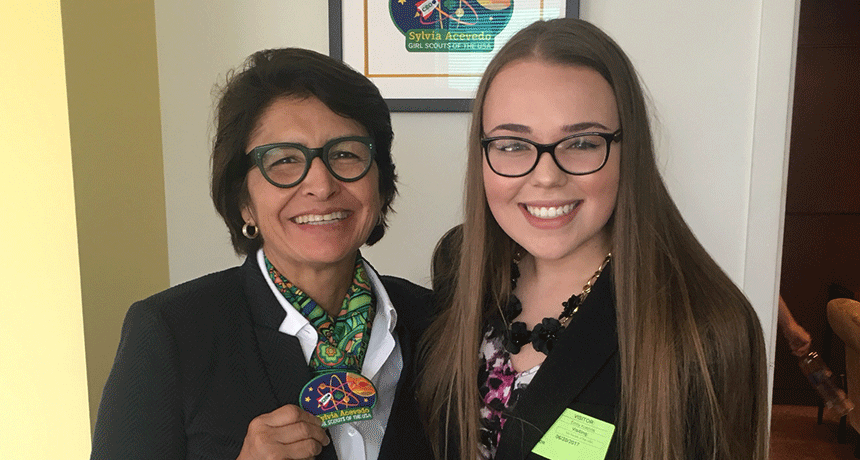Teen interviews science role models to inspire others
Armed with a GoPro, a high school student informs her peers about STEM careers

Emily Koehne (right) interviewed Sylvia Acevedo (left), leader of the Girl Scouts of the United States, for her YouTube video series about women in STEM.
E. Koehne
Girls who want to go into science, technology, engineering or math (STEM) sometimes have a tough time finding role models. That’s because men still outnumber women in many of these fields. Some teens might think that’s a problem they’ll solve by going into a STEM field and becoming a role model themselves. But Emily Koehne, 17, decided not to wait. The senior at the Immaculate Heart Academy in Washington, N.J., actively searches out female role models in STEM and shares her interviews with them on her own YouTube channel.
“I never had any role models for girls in STEM when I was younger,” Emily explains. For instance, female scientists on TV were weird or geeky, she says. “They were never portrayed in a positive manner.”
The teen got a chance to change that when she entered a contest run by Marvel and the National Academy of Sciences that challenged girls to create videos answering STEM-based questions. (The contest was also sponsored by Society for Science & the Public, which publishes Science News for Students and this blog). Emily created a video in which she 3-D printed a doll named “STEMily” with whom she discussed problems of women in STEM.
She didn’t win the contest. But Emily didn’t mind. She had discovered just how much she liked making videos. “I couldn’t stop there,” she says. Using money she earned through pet sitting, the teen bought a GoPro camera and set up a website, which she used to start her own YouTube channel, STEMily<K>.
Emily set out to interview women in STEM about their careers and share those interviews with teachers and fellow students. But she quickly ran into a problem. She didn’t have any STEM role models. Encouraged by her former science teacher Sharon Mistretta, the teen searched the internet for women in STEM to interview. Then she sent emails asking for those women to speak with her.
Many of the scientists responded and were eager to participate. Dianna Cowern, a science communicator known for her YouTube channel Physics Girl, was one of them. She was thrilled to see someone in high school promoting women in STEM. Emily, Cowern says, “clearly has thought through issues that women face in STEM, in a way I hadn’t thought about until I was out of college. I was really impressed with her.”
Emily plans, shoots and edits the videos herself, spending hours on each one. “The interviews take an hour,” she says, but the final videos are usually only 8 to 12 minutes long. “There’s so much great information,” Emily notes. “But girls won’t spend an hour [watching], so I try to … put the most important information in that I think girls really want to know.”
The teen hopes to inspire other teens with the scientists she interviews. She’s already found a new science hero in Sylvia Acevedo. Trained as an engineer, Acevedo now heads the Girls Scouts of the United States of America. And she gladly sat down for an interview with Emily. “She’s impacting girls on a level I’d love to achieve some day,” the teen says of Acevedo. “She’s taken her experience and now she’s giving back.”
Emily’s YouTube channel is still new, and her goal is to post four videos a month. The teen is trying to get the word out about her project to attract more viewers to her channel. She’s also looking for more STEM role models who blend several interests, such as science and fashion. “I want to show girls you can be well rounded and interested in STEM as well as interested in other things, so girls won’t be discouraged and pick the other things over STEM,” she says.
And her new hobby has made her more determined than ever to pursue a career in computer science. She says, “I’m doing what I love.”
Follow Eureka! Lab on Twitter